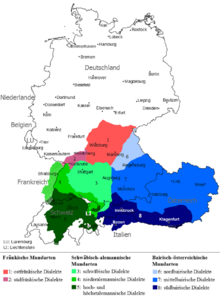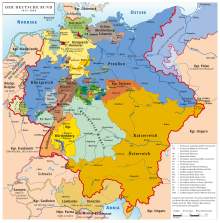Southern Germany
The term southern Germany has several different aspects that conflict with a uniform definition. A distinction must be made between political, historical, geographical, religious, linguistic and cultural aspects, which among other things have the effect that, in contrast to northern Germany, less sense of community has developed. The main characteristic of the south of the German-speaking area is the diversity of dialects resulting from the stronger topographical structure .
According to the New Brockhaus 1960, southern Germany is “the part of Germany south of the central German mountain threshold , for example the states of Bavaria, Baden-Württemberg, southern Rhineland-Palatinate and Hesse south of the Main. It is made up of the area of the Upper Rhine Plain, which is usually referred to as southwestern Germany , and the subsequent step landscape , the Upper German Plateau (south of the Danube) and the German Alps. "
Linguistically , most of southern Germany belongs to the Upper German-speaking area , which also includes Austria , Liechtenstein , German-speaking Switzerland and South Tyrol . Politically , it refers to an area in the south of the Federal Republic of Germany , which was founded in 1949 , namely the states of Baden-Württemberg and Bavaria . In a more cultural context, one also includes South Hesse , Saarland and the Palatinate . The Saarland, Rhineland-Palatinate , Baden-Wuerttemberg and the south of Hesse form the south-west , Bavaria the south-east of the Federal Republic.
Linguistic and confessional character
As with other regional terms, there is no defined border in the case of southern Germany . Usually the Main is given as the border, because the part of Hesse in the Upper Rhine Plain is also south of the Main and has a special cultural, economic and linguistic connection to southern Germany. Upper German dialects are spoken in most parts of southern Germany .
The original linguistic allocation follows the division of the German-speaking area into a Low German language area in Northern Germany and a High German language area adjoining it to the south , whose dividing line runs along the Benrath line (the Rhineland and parts of Thuringia are also to the south of it). The High German-speaking area is for its part subdivided into a Central German area located in the middle third of the Federal Republic and an Upper German area located in Southern Germany.
Overall, southern Germany - like the Rhineland - is largely shaped by Roman Catholicism compared to northern and eastern areas of Germany , although southern Germany also has Protestant regions, such as Central Franconia or Old Württemberg .
Historical-political influences
Not insignificant for the fact that the term southern Germany is difficult to define are the political and historical developments in this area, especially with regard to the Holy Roman Empire (since around 1500 sometimes with the addition of “ German nation” ) and its development. After all, the Habsburg emperors, who were predominantly Habsburg emperors from the 14th century onwards, expanded the empire in a south-easterly direction, and on the other hand, after the Reformation , strengthened the Catholic element again and at the same time increased the religious and cultural diversity of the southern half of the empire. The Napoleonic wars and their changing alliances also made a strong contribution to regional-political differentiation and brought about the dissolution of the empire in 1806.
When the German Confederation (1815–1866) was founded after the Congress of Vienna , a new differentiation emerged: large countries in the south and north, but in between small princes and duchies from the Palatinate to Hesse to today's Thuringia . The German question that soon broke up - a German nation-state under the leadership of the Austrian Empire or under its exclusion ( small German solution 1866) - became even more essential for the feeling of belonging . It became the last essential factor - among other things for the urgent question at the beginning of the 20th century whether Austria belongs to the German nation or not. Since this question from the Prussian Austrian-power dualism originated and Austrian-Prussian war resulted, it became at times aspirations a third pole of power as Third Germany to form, but which in a disagreement over the role of Bavaria as the most influential part of a corresponding Süddeutsche State Union failed, and in an affiliation to the North German Confederation , or in the founding of the German Empire .
But as soon as the possibility of uniting Bavaria with Austria was lost under Emperor Josef II , the tendency in both countries to no longer necessarily count Austria as part of "Southern Germany" increased. For Switzerland this was only a question in terms of linguistic geography.
Geographic aspects
In the geographical sense, "Southern Germany" is defined in Brockhaus as the part of Germany that lies south of the Central German mountain range - that is, the states of Bavaria and Baden-Württemberg as well as southern Rhineland-Palatinate and Hesse south of the Main. Geomorphologically it is the area from the Upper Rhine Plain over the subsequent step landscape to the Upper German Plateau (south of the Danube), to which the German part of the Alps and the Bohemian Forest come. This definition essentially comes from Robert Gradmann in 1931.
Politically and culturally, however, South Hesse as well as Rhine Hesse and the Palatinate are only part of South Germany to a limited extent. Geographically and culturally, Austria and South Tyrol should also be included, but this became irrelevant due to the politics of the 20th century.
Main line
As with the development of this term during the German War of 1866, the Main Line mentioned above cannot be strictly localized on the course of the Main. In Hesse, the cultural border between Central Hesse and South Hesse is probably more in the Taunus than on the Main. Further east, the borders between dialects and other traditions do not run in the Main Valley, but in the low mountain ranges north and south of it.
Economic migration
For a long time now, economic growth and unemployment have been more favorable in the south of Germany than in the north, which is why economists are investigating migration movements, which are predominantly from north to south. Because of the more conclusive data available, the southern German region is equated with the federal states of Bavaria and Baden-Württemberg .
use
The sprachgeografische name "Southern Germany" in contrast to the political use of the term after the Second World War includes all southern German areas within the meaning of Upper Germany as what has been preserved in individual names (eg. Pratos Süddeutsche kitchen , now as good old kitchen with ISBN 978-3-85431-426-4 reissued). In this sense, names like South-North German Connection Railway were to be understood, which referred to a railway connection from Vienna to Berlin.
literature
- The new Brockhaus. All book in five volumes and an atlas . Used v. a. Volume V (Southern Germany), Volume 2 and 4 (Germany, Austria), Volume 6 (Atlas). F. A. Brockhaus, Wiesbaden 1958-1960.
- Robert Gradmann : Southern Germany (Volume I: General Part , Volume II The Individual Landscapes ). Verlag Engelhorn, Stuttgart 1931. Reprint: Wissenschaftliche Buchgesellschaft Darmstadt.
- Ilse Hell, Christian Bayer et al .: Lexicon of World History (used mainly HRR, Germany, Reformation, German Confederation). Compact-Verlag, Munich 2002.
- Geoffrey Barraclough (Ed.): Knaur's New Historical World Atlas. Bechtermünz and Droemersche Verlagsanstalt, Munich 1995.



